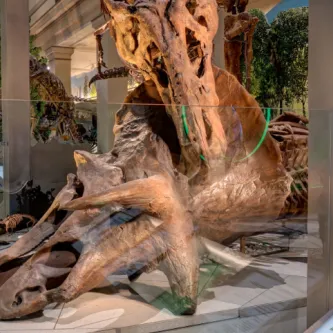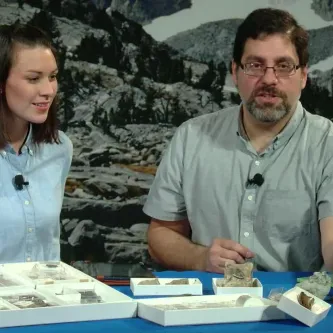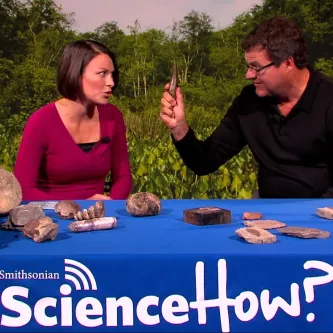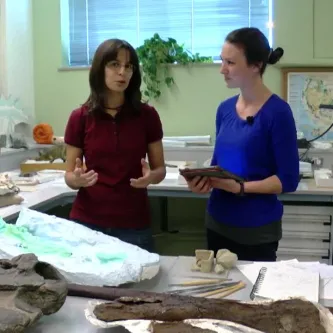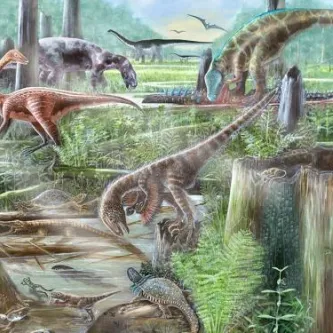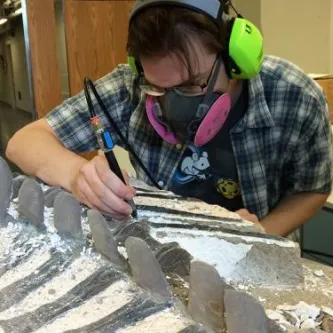Search
A New View of T. Rex
A Rare Find in Montana
In 1988, amateur fossil hunter Kathy Wankel made an unusual and extremely valuable find while on a family camping trip in Montana. A bone sticking out of the ground turned out to be part of the fossilized skeleton of a Tyrannosaurus rex. The entire skeleton, now known as the Wankel T. rex, was excavated and displayed at the Museum of the Rockies. In 2013 it was prepared for its journey to Washington, D.C., where it is on loan to the National Museum of Natural History for the next 50 years. It is one of the most complete skeletons of T. rex ever discovered.
Piecing Together the Evidence
Unlike the Wankel T. rex, most fossil remains of tyrannosaurids and other dinosaurs are fragmentary. For example, analyzing dinosaur remains in Uzbekistan, Dr. Hans Sues had to piece together the evidence. To date, most of the fossils from more than 60 digs are just tyrannosaurid teeth. Rarely, skull bones or bone fragments have been found. Still, Hans Sues was able to fill gaps in the fossil record for tyrannosaurs from the late Cretaceous.
Fossil Preparators such as Michelle Pinsdorf work to clean, repair, and assemble the bones. The goal is to treat the bones in a way that protects them so that they remain useful for research in the long run. Michelle makes drawings and takes photos to record information about the bones. Preparing a fossil T. rex skeleton found in South Dakota, she was able to see that it was an adult due to the fusion of certain skull bones and the texture on the nose bones.
Striking the Right Pose
Tyrannosaurus rex was one species in a family of predatory dinosaurs (Tyrannosauridae) that lived during the Cretaceous (66–68 million years ago) and walked on two legs. T. rex was the largest tyrannosaurid dinosaur. Like other tyrannosaurs, they had wide heads and long, thick tails. Old drawings of T. rex showed it standing upright. Further analysis of the body form and weight balance led paleontologists to conclude that its body was parallel to the ground. The chunky tails served to counterbalance its large head.
A team of Paleontologists including Dr. Matthew Carrano collaborated to decide on an interesting and realistic body position for the Wankel T. rex. The positioning of T. rex and other dinosaur mounts in museums are reevaluated every so often based on new findings. Steve Jabo, a Preparator of vertebrate fossils, and others at the National Museum of Natural History have reassembled Triceratops and Stegosaurus skeletons into more realistic poses, using evolving knowledge about how their bones and muscles fit together.
Modern, digital ways of capturing information about objects help museums collect and maintain information about fossil bones. Smithsonian experts in laser scanning technology captured information about the Dinosaur Hall at the museum in preparation for renovation. Laser scanning can also be used to prepare specimens, such as the Wankel T. rex, for display by providing a database that can be used to see how different poses would look. Should the T. rex be walking? Tearing apart prey?
Reading the Natural History in the Bones
Any pose will reveal the short forearms of T. rex. The Wankel skeleton was the first skeleton complete enough to show how truly short its arms were. While short, they were strong, evidenced by large muscle attachment areas on the bones. How could a T. rex have used its short, strong arms? Paleontologists have speculated that they might have been used to clasp a mate or push up their large bodies up from a lying-down position, but much more study is needed.
T. rex is often shown running after its prey, its large, banana-shaped teeth bared. In fact, T. rex may not have been able to run quickly. But neither could its prey, which were built for even slower speeds, so this probably wasn’t a problem. That is not to say that a T. rex was not fast. Paleontologists estimate its maximum walking speed as high as 25 miles per hour (40 km/hr), thanks to its huge stride.
The first probable fossil of a T. rex was discovered by Paleontologist Edward Drinker Cope in 1892 and named Manospondylus gigas. It was very fragmentary — just a single bone — so it took many years to recognize it as belonging to a T. rex. But the original Tyrannosaurus rex was discovered by Barnum Brown in eastern Montana, and it was given its famous name in 1905 by Henry Fairfield Osborn.
The Largest Biped on the Planet
Because of its impressive size — the largest biped ever known — T. rex has been a subject of study to determine how it stood and walked. Many scientists have attempted to understand its musculature and function. Recent work by Matthew Carrano showed that T. rex had leg muscles that were intermediate between those of crocodilians and birds in many ways, and that its stride was probably closer to that of a mammal (lots of hip joint motion) than a bird (lots of knee joint motion).
At least one relative of T. rex was even feathered. Fossils of the early tyrannosaur Dilong paradoxus had feather-like structures on its body. These may have been lost in larger tyrannosaurids or restricted to small patches of skin. The mass extinction event at the end of the Cretaceous (66 million years ago) claimed T. rex among its victims, leaving paleontologists to learn about it through the fossil record and comparison to modern organisms.
The Wankel T. rex went on display in the new National Fossil Hall at the National Museum of Natural History in June 2019!
